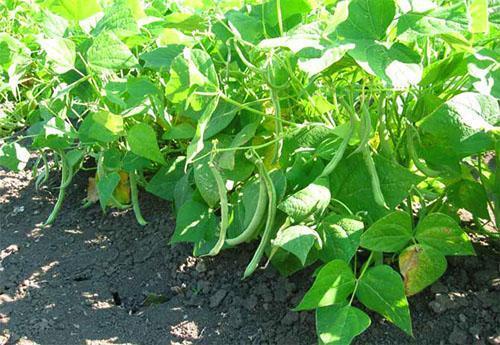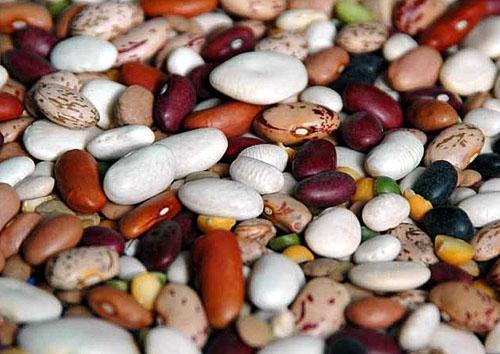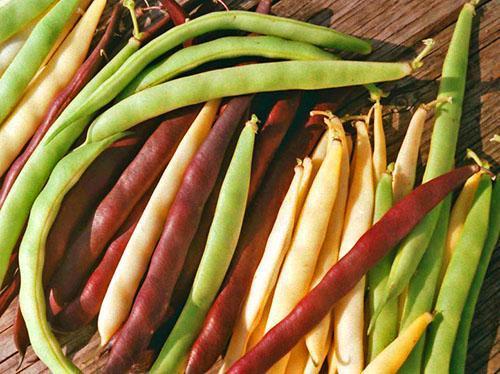We study vegetable culture - green beans
 Legumes occupy a special place among plant products. Vegetable protein of beans is a complete substitute for animals, and vitamin and mineral compositions make this vegetable extremely useful. Among the numerous plant species, a special place is occupied by green beans, green or asparagus, they have many names.
Legumes occupy a special place among plant products. Vegetable protein of beans is a complete substitute for animals, and vitamin and mineral compositions make this vegetable extremely useful. Among the numerous plant species, a special place is occupied by green beans, green or asparagus, they have many names.
History reference

Cereals and legumes together complement the set of amino acids, thereby forming the protein that is needed for the existence of life. For humans, such a protein of plant origin is a complete replacement for an animal.
Beans, like other legumes, are popular in the world, are an essential food staple and occupy large acreage all over the world. If earlier beans were grown only in regions with a warm climate, now there are early ripening varieties that made it possible to get a vegetable on personal farmsteads in Siberia. Asparagus green beans are more often preferred.
Growing beans
 Of the many species, the climate of our country allows the cultivation of green beans. Asparagus also belongs to the green beans. It differs in the length of the pod, which can reach a meter, and in the absence of a rigid reinforcing thread in the pod. The heat-loving plant is cultivated on an industrial scale in the southern region. However, a rare suburban area does without bean bushes. There are bush and curly forms of green beans.
Of the many species, the climate of our country allows the cultivation of green beans. Asparagus also belongs to the green beans. It differs in the length of the pod, which can reach a meter, and in the absence of a rigid reinforcing thread in the pod. The heat-loving plant is cultivated on an industrial scale in the southern region. However, a rare suburban area does without bean bushes. There are bush and curly forms of green beans.
In addition to the fact that the culture is thermophilic, it can grow effectively only if the following conditions are met:
- the correct choice of sowing site and soil preparation;
- watering and plant feeding;
- the use of regionalized seed varieties;
- disease and weed control;
- timely harvesting.
How to plant beans in a summer cottage?
 The soil should be light, represent sandy loam, loam with deep groundwater. You should not expect a good result on heavy damp areas. The prepared place should be cleared of perennial weeds, protected from northern winds and located in an area open to the sun.
The soil should be light, represent sandy loam, loam with deep groundwater. You should not expect a good result on heavy damp areas. The prepared place should be cleared of perennial weeds, protected from northern winds and located in an area open to the sun.
Curly shapes can be used for landscaping or grown along mesh fences or with special supports. Shrub is sown in rows on raised beds... On such hills, the soil warms up faster, and beans germinate at 20-25 0.
 When sowing seeds in warm soil in June, seedlings will appear in 2-3 weeks, subject to constant soil moisture. The seeds are soaked before planting, sown to a depth of 2-5 cm, with a distance between the bushes of about 10 cm and row spacing of 25-40 cm, depending on the power of the selected variety. How to plant beans for green hedging and harvest? When sowing seeds, vertical supports are installed immediately on the south side of the building, and the seeds are planted in one row.After germination, the strongest plant is left in the hole, the rest are broken out so as not to damage the roots of the remaining seedling.
When sowing seeds in warm soil in June, seedlings will appear in 2-3 weeks, subject to constant soil moisture. The seeds are soaked before planting, sown to a depth of 2-5 cm, with a distance between the bushes of about 10 cm and row spacing of 25-40 cm, depending on the power of the selected variety. How to plant beans for green hedging and harvest? When sowing seeds, vertical supports are installed immediately on the south side of the building, and the seeds are planted in one row.After germination, the strongest plant is left in the hole, the rest are broken out so as not to damage the roots of the remaining seedling.
How to grow beans during the season?
 Grown young plants need to be loosened and hilled. Weeds should be removed throughout the season; beans do not like being close to other plants. Determines the yield of the bed by the content of phosphorus and potassium salts in it. Beans do not like organic nitrogen, they can get sick. During the growing season, it itself enriches the soil with nitrogen, like other legumes.
Grown young plants need to be loosened and hilled. Weeds should be removed throughout the season; beans do not like being close to other plants. Determines the yield of the bed by the content of phosphorus and potassium salts in it. Beans do not like organic nitrogen, they can get sick. During the growing season, it itself enriches the soil with nitrogen, like other legumes.
 It is important to provide the plant with abundant watering during growth. The more moisture the plant receives, the thicker, fleshy the pod leaves will be. Plants that serve as a living wall are pinched at a height of 2 m so that they go to the filling, otherwise there will be only flowers.
It is important to provide the plant with abundant watering during growth. The more moisture the plant receives, the thicker, fleshy the pod leaves will be. Plants that serve as a living wall are pinched at a height of 2 m so that they go to the filling, otherwise there will be only flowers.
During the growth of the beans, it will be useful to organize feeding ash or ash extraction. All fertilizing is done only on wet ground. Harvesting depends on the timing of ripening. Since green beans are used more often, they are removed gradually in several steps when the pod is formed.
 It is considered normal development when beans bloom after 35-40 days, after 2 weeks ovaries will appear. But the early varieties can yield in 45-60 days, the middle ones in the third month, and the later ones are ready for harvesting in 3.5-4 months.
It is considered normal development when beans bloom after 35-40 days, after 2 weeks ovaries will appear. But the early varieties can yield in 45-60 days, the middle ones in the third month, and the later ones are ready for harvesting in 3.5-4 months.
Pests and diseases of beans
 Crops of beans, like other legumes, can be affected by:
Crops of beans, like other legumes, can be affected by:
- slugs;
- spider mite;
- pea aphid;
- snails.
With proper agricultural technology, damage is minor. It is impossible to use chemicals at the time of pouring the pods. You can use deterrent folk remedies. Slugs can be trapped.
 In order for the plants not to get sick, it is necessary to thin out the plantings, since anthracosis is always preceded by long inclement weather and thickening of the plants. When fungal diseases appear on one bush, it is better to remove it so that the disease does not spread to neighboring bushes. For the prevention of diseases, you can use a serum solution diluted 1: 5 with water.
In order for the plants not to get sick, it is necessary to thin out the plantings, since anthracosis is always preceded by long inclement weather and thickening of the plants. When fungal diseases appear on one bush, it is better to remove it so that the disease does not spread to neighboring bushes. For the prevention of diseases, you can use a serum solution diluted 1: 5 with water.
How to harvest green beans and where to store the crop
 You need to collect green beans and asparagus many times, not allowing it to go from milk ripeness to waxy. Overripe beans coarse, acquire bitterness and become suitable only for obtaining seeds.
You need to collect green beans and asparagus many times, not allowing it to go from milk ripeness to waxy. Overripe beans coarse, acquire bitterness and become suitable only for obtaining seeds.
Plucking young pods, the plant is stimulated to form new fruits. Therefore, with regular harvesting, the yield of the plant is higher. Before collecting green beans, you need to think about ways of preserving them. Fresh product is not suitable for storage, therefore, freeze or preserve herbs should be arranged.
If the beans are coarse, they are not suitable for use in pods, but it is too early to pick them for seeds. Therefore, it is finally possible to remove the beans from the garden bed when the pods dry up and the flaps begin to open. The full ripening period directly depends on the type of beans. To prevent the beans from getting wet by the rain that has passed, the plants are pulled out of the ground, tied in a broom and placed in a ventilated room for drying. Later, the broom is threshed.